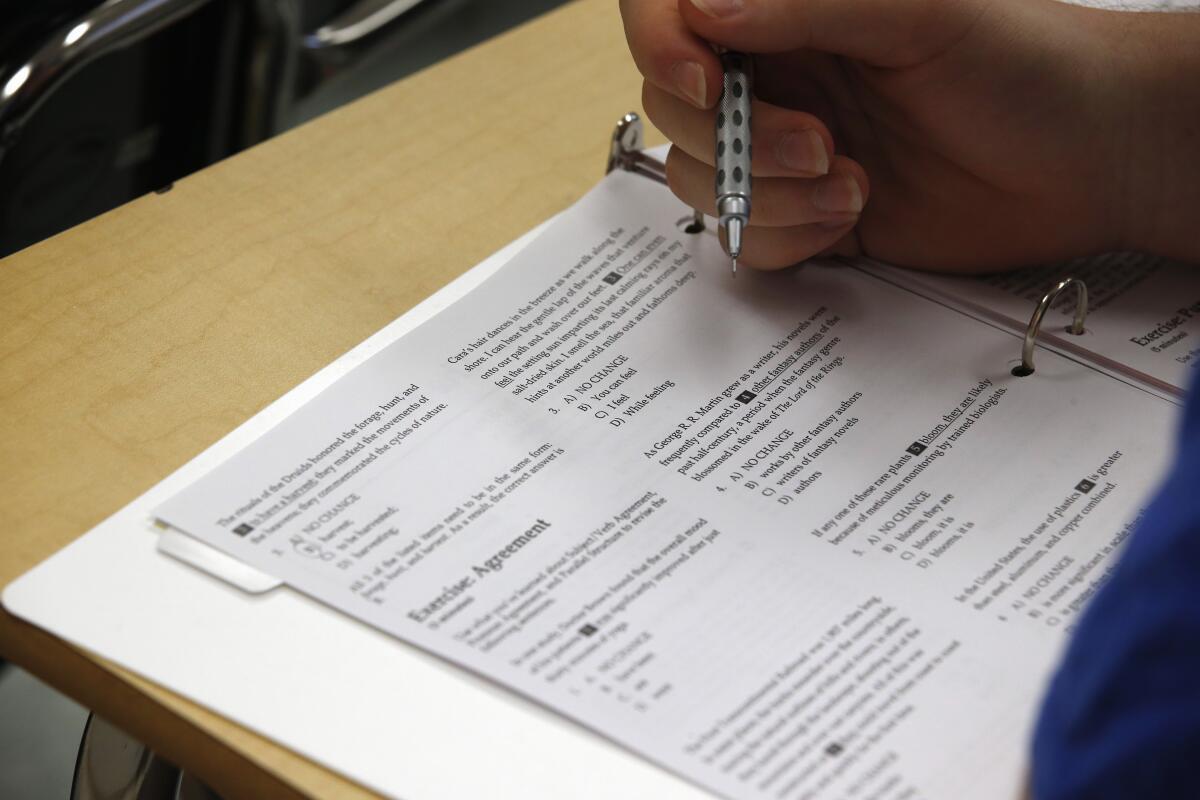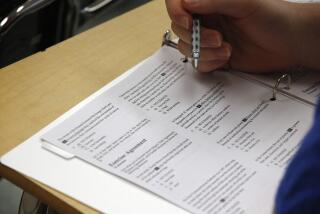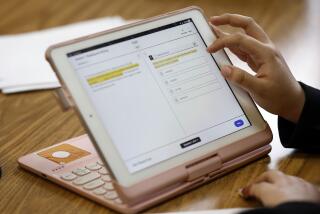Big changes for controversial SAT: Digital, shorter and a unique test for each student

- Share via
The controversial SAT exam, dumped as an admission requirement by the University of California, will move to an all-digital format with shorter, more concise content that is expected to better prevent cheating and widen access to an exam that is coming under growing scrutiny as a gatekeeper in the college application process.
The College Board, which owns the test, unveiled the changes Tuesday. They will be rolled out for international students in spring 2023 and for U.S. students in 2024. The duration of the test, which will be administered at schools and testing centers with proctors, will be cut from three to two hours. Long reading passages will be shortened.
In a key change, the digital format will allow for a unique test for each student. That will increase security — test takers can’t crib an answer from someone else — but could raise questions about how to fairly assess students who are taking different tests.
The announcement comes amid a growing national movement to eliminate standardized testing requirements for admissions decisions. More than 1,800 colleges and universities — nearly 80% of U.S. institutions that grant bachelor’s degrees — have dropped requirements for fall 2022 applicants, with most making submission of test scores optional, according to the educational organization FairTest, the National Center for Fair & Open Testing.
California State University, the nation’s largest four-year university system, will begin debate on whether to permanently end testing requirements during Wednesday’s meeting of the Board of Trustees, after an admission advisory council recommended doing so.
It’s unclear whether colleges and universities will reinstitute testing requirements after the pandemic eases or whether the digital exam will help the College Board rebuild its SAT market.
SAT test takers dropped from 2.2 million in the class of 2020 to 1.5 million the following year, rising to 1.7 million so far for current high school seniors. The College Board declined to provide data on SAT test revenue during those years.
Critics of college admissions testing at UC and Cal State have said standardized tests don’t predict college academic performance as well as high school grades do and produce biased results based on race, income and parents’ education level. UC, the nation’s premier public research university system, jettisoned the SAT and ACT in 2020 after more than a year of research and debate. The Board of Regents’ unanimous vote was rooted in concerns that the test posed an unfair admission barrier to underserved students and brought no significant value to admissions decisions.
But high schools — including those in L.A. Unified — are continuing to give the test and many counselors are recommending that students take it. The College Board says there is overwhelming demand for it, especially since many of the nation’s most competitive universities — including the Ivy League, Stanford and USC — have not eliminated it.
Priscilla Rodriguez, the College Board’s vice president for college readiness assessments, said 83% of students surveyed by the nonprofit wanted the option to take the test and submit their scores.
“Let students take it, see how they do and see if they feel it reflects their strengths,” she said of the test. “If it does, they put it forward. If it doesn’t, they don’t.”
Standardized testing critic Bob Schaeffer, FairTest’s executive director, said no retooling will improve the SAT’s value but that shifting market dynamics called for a College Board response. He noted that the rival ACT Inc. launched a digital international test a few years ago and UC’s decision to drop the SAT reduced its relevance for California students.
“They need to reposition their product because of significant drop-off in test taking and because the nation’s most prestigious public university system will never use it again,” he said. “Shifting an unnecessary, biased, coachable, and poorly predictive multiple-choice exam that few schools currently require from pencil-and-paper delivery to an electronic format does not magically transform it into a more accurate, fairer or valid tool for assessing college readiness.”
Rodriguez said feedback from students, parents and colleges prompted many of the changes. One concern has been the risk of security breaches when paper tests are shipped across the globe and compromised — as has occurred in South Korea and China, leading to widespread test cancellations. Such problems in part prompted the College Board to step up efforts to develop a more secure digital test over the last few years, Rodriguez said.
But the digital format also benefits schools, she added, because it allows them more flexibility over testing dates. Because each test is unique, the SAT no longer has to be given to all students at the same time to prevent the sharing of information. About 60% of test takers can do so at their campuses during school hours, rather than having to travel to testing sites on weekend days set by the College Board. The digital format will allow schools to decide when to give the exam.
Students will be able to use their own devices, such as a laptop or tablet, or a school-issued device. For those without a device, the College Board will provide one to use on test day. If students lose connectivity or power, they won’t lose their work or time while they reconnect. After a student has logged in to the test, its design prevents the opening of new tabs to search online for answers.
The new test also features a more user-friendly format. Long reading passages with several questions have been streamlined to shorter texts with one question tied to each over a greater variety of topics.
Kirsten Amematsro, a Virginia high school junior who took the pilot digital test last fall, said she much preferred the more concise reading format.
“It helped me focus better and took less time because I wasn’t wasting time reading long passages scanning for the wrong answer,” said Kirsten, 16.
She added that the built-in timer at the top of the screen helped her pace herself, and the embedded digital calculator alleviated stress over making sure to bring her own. Scores were not provided for the pilot digital test, but Kirsten said she felt she did better than with the paper version last year, when she scored in the 82nd percentile.
“There’s really no difference in the hardness of the test, but there was definitely less stress, and it was easier to use,” she said.
Overall, 80% of U.S. and international students who took the pilot test in November said it was less stressful, said the College Board, which conducted the survey. Rodriguez added that the core skills of reading, writing and math — important for college readiness and career success — will be assessed just as thoroughly in the digital format as the print version.
The College Board provided a list of students who had taken the pilot test, including Kirsten, and educators who reviewed materials, including admission directors at MIT, Yale and USC. Unlike UC, those three universities have not ruled out returning to testing requirements after the pandemic, saying that SAT scores provide a useful piece of information in assessing applicants during their comprehensive review process, along with grades, course rigor, essays and extracurricular activities.
At Yale, for instance, test scores are the single most effective factor in predicting a student’s first-year and four-year grade-point average, said Jeremiah Quinlan, dean of undergraduate admissions and financial aid.
Stuart Schmill, MIT dean of admissions and student financial services, said applicants to his campus have similar high grades, so the test score adds an important factor to differentiate them. He also said it helps students who don’t have equitable access to high-level courses demonstrate their college readiness.
The UC Academic Senate came to similar conclusions about the value of the SAT in its review of standardized testing and recommended that testing requirements be kept for now, but the Board of Regents disagreed.
UC Berkeley Chancellor Carol Christ, who was one of the first UC leaders to call for an end to testing requirements and directed the campus to experiment with dropping them even before the regents voted to do so, said she would adopt a wait-and-see attitude on the digital format.
“I don’t see how the change to a digital format will change the fact that the results of the SAT are most closely correlated with family income,” she said Tuesday.
The Yale, MIT and USC admission leaders all said their application review process controls for testing bias by evaluating scores in the context of a student’s school and community. They endorsed the digital format and other changes as an innovative step forward in the testing landscape.
“It’s a move of the College Board into the 21st century when it comes to improving the testing experience for students,” said Kedra Ishop, USC vice president of enrollment management. “It’s going to be easier to take for students. It’s more secure and more relevant to a broader set of students. And that’s a step in the right direction.”
More to Read
Sign up for Essential California
The most important California stories and recommendations in your inbox every morning.
You may occasionally receive promotional content from the Los Angeles Times.











